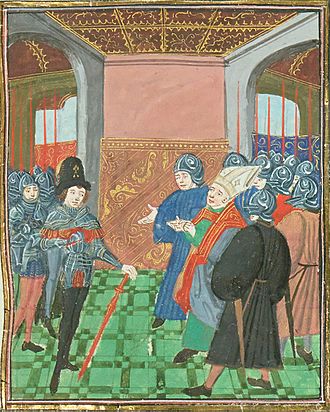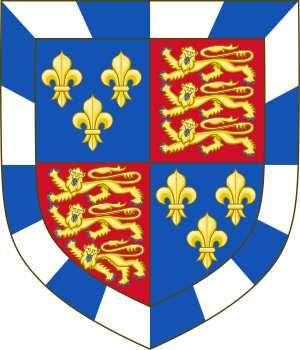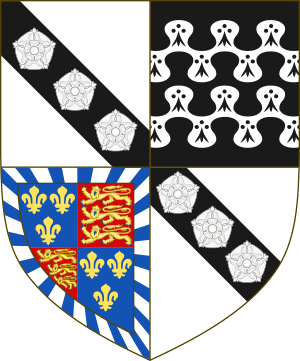Edmund Beaufort, 2nd Duke of Somerset facts for kids
Quick facts for kids
Edmund Beaufort
|
|
|---|---|

Edmund Beaufort (left) meeting French envoys at Rouen, from a old book (around 1470–80)
|
|
| Born | 1406 |
| Died | 22 May 1455 (aged ~49) St Albans, Hertfordshire, England
|
| Resting place | St Albans Abbey |
| Nationality | English |
| Opponent(s) | Richard, Duke of York |
| Spouse(s) | Eleanor Beauchamp |
| Children | 10, including:
|
| Parent(s) | John Beaufort, 1st Earl of Somerset Margaret Holland |
| Family | Beaufort |
| Military career | |
| Battles/wars | Hundred Years' War Wars of the Roses |
| Awards | Order of the Garter |

Edmund Beaufort, 2nd Duke of Somerset (born 1406, died 22 May 1455) was an important English nobleman. He played a big part in the Hundred Years' War, a long conflict between England and France. His strong rivalry with Richard, Duke of York, was a main reason for the start of the Wars of the Roses, a series of civil wars in England.
Contents
Who Was Edmund Beaufort?
Edmund Beaufort was the fourth son of John Beaufort, 1st Earl of Somerset. His grandfather was John of Gaunt, who was a son of King Edward III. This made Edmund a cousin to both Richard, Duke of York, and the Lancastrian King Henry VI.
Even though he came from a powerful family, Edmund didn't inherit a lot of money. His rival, Richard, Duke of York, was much wealthier. King Henry VI tried to help Edmund by giving him important jobs. However, this upset many other nobles. As Edmund's disagreement with York grew, the political situation in England became very unstable.
Edmund's Military Career
Edmund gained a lot of military experience early in his life. His older brothers were captured during the Battle of Baugé in 1421. Edmund was too young to fight then, but he learned a lot while his brothers were prisoners.
He became a commander in the English army in 1431. In 1432, he was one of the people sent to the Council of Basel, an important meeting. He had some big successes, like taking back Harfleur and ending the siege of Calais by the Burgundians. Because of these victories, he was made a Knight of the Garter in 1436.
Rising Power and Conflict
Edmund continued to rise in power. He was made Earl of Dorset in 1442 and Marquess of Dorset in 1443. From 1444 to 1449, he served as the Lieutenant of France during a five-year truce. In 1448, he was given the title of Duke of Somerset. He is sometimes called the "second" duke, but the title was actually created again for him, so he was the first Duke of Somerset of this new creation.
In 1448, Somerset was chosen to replace York as the main commander in France. However, things did not go well. Somerset's military failures led to a lot of criticism from York's supporters. A very difficult moment was when he gave up Rouen, the capital of Normandy, to the French without much of a fight.
By the summer of 1450, England had lost almost all its lands in northern France. Normandy fell after the Battle of Formigny and the Siege of Caen. By 1453, all English lands in southern France were also lost. The Battle of Castillon marked the end of the Hundred Years' War.
Political Struggles in England
After the Duke of Suffolk lost power, Somerset became the King's most important minister. He had a lot of influence, and Margaret of Anjou, King Henry VI's wife, was one of his main allies.
In 1453, King Henry VI became very ill. He suffered a mental breakdown and was unable to rule for about a year and a half. During this time, Somerset's rival, York, took power as Lord Protector in April 1454. York then had Somerset put in the Tower of London.
Somerset was likely saved when the King seemed to get better in late 1454. This forced York to give up his position. Henry agreed to recognize his son, Edward, as his heir. Somerset was released and given back his important job as Captain of Calais.
However, York was determined to remove Somerset from power. In May 1455, York gathered an army. He met Somerset and the King's forces at the First Battle of St Albans. This battle was the start of the Wars of the Roses. Somerset was killed during a final charge from the house where he had been hiding. His son, Henry, never forgave York for his father's death.
Family Life
Between 1431 and 1433, Edmund Beaufort married Eleanor Beauchamp. She was the daughter of Richard de Beauchamp, 13th Earl of Warwick. Eleanor was also the half-sister of Anne de Beauchamp, who was married to Richard Neville, 16th Earl of Warwick, known as the "Kingmaker".
Edmund and Eleanor had several children, including:
Sons
- Henry Beaufort, 3rd Duke of Somerset (1436–1464): He was the oldest son and inherited his father's title. He was beheaded after the Battle of Hexham, where he led the Lancastrian army. He had an illegitimate son:
- Charles Somerset (around 1460–1526): He was given the surname "Somerset" and became the first Earl of Worcester. The current Dukes of Beaufort are descended from him.
- Edmund Beaufort, 4th Duke of Somerset (1439–1471): He became duke after his older brother. He was executed two days after being defeated at the Battle of Tewkesbury in 1471. He died without marrying, and with his death, the main male line of the Beaufort family ended.
- John Beaufort, Earl of Dorset (1441–1471): He was killed fighting for the Lancastrians at the Battle of Tewkesbury on the same day his brother was defeated. He also died without marrying.
Daughters
After their brothers died without children, these daughters became co-heiresses to their father's family. Their descendants were allowed to use the Beaufort family's coat of arms.
- Eleanor Beaufort (1431–1501): She married James Butler, 5th Earl of Ormond first, and then Sir Robert Spencer. Her descendants include the Cary family, who became Viscount Falkland, Baron Hunsdon, and Earl of Monmouth.
- Joan Beaufort (1433–1518): She married Robert St Lawrence, 3rd Baron Howth and then Sir Richard Fry.
- Anne Beaufort (1435–1496): She married Sir William Paston.
- Margaret Beaufort, Countess of Stafford (1437–1474): She married Humphrey, Earl of Stafford and then Sir Richard Darell.
- Elizabeth Beaufort (1443–before 1475): She married Sir Henry Fitz Lewis.
- Mary Beaufort (born between 1431 and 1455).
Images for kids
-
Edmund surrenders to Charles VII at Rouen in 1449.



